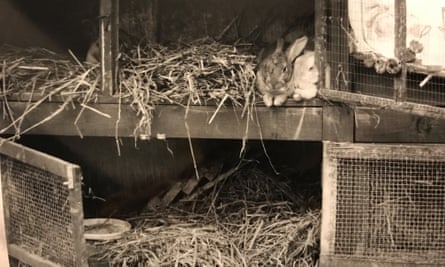
When my beloved guinea pig Nutty died, I found myself yearning for something to fill the furry-animal-shaped hole in my life. Not wanting to betray his memory with another guinea pig, I went for rabbits. But when I set my sights on Thumper, I had no idea what I was getting myself into.
She was a perfectly white bunny, with large floppy ears that dragged on the ground as she hopped and covered her face as she slept. She had a cute round bottom and twitched her nose when she could smell food.
Our home in rural Warwickshire was the perfect place for her. She and Chester, the other rabbit I got at the same time, spent their days chasing each other around a pen in the garden and slept in a two-storey hutch filled with hay.
She could be boisterous and greedy – my dad called her “the fat one”. And she always seemed to have a horde of wild rabbits flitting around near her on the other side of the chicken wire.
I hadn’t planned for her to breed. Chester was also female. But one afternoon in April 2017 I got home from school to find nine newborn kittens, lying in the hay, hairless and looking more like tiny rats than miniature Thumpers. I quickly discovered that Thumper would let me nowhere near them unless I brought food.
What I couldn’t understand was how she had got pregnant. Immaculate conception was the first thing that came to mind – it was Easter, after all. Then a quick Google search revealed that rabbits can do what they are famous for even through chicken wire.
The vet told me Thumper had got frisky with a wild rabbit, she had been pregnant for only a month and, because this was her first litter, the kittens weren’t likely to survive for long.
But Thumper had no intention of giving up, and she did all she could to keep them fed and warm. To our surprise and delight, we were eventually left with three healthy bunnies, who we named Snap, Crackle and Pop. We kept all of them, and this happy little family remained in our garden eating all our spare grass and vegetables. They dug what can only be described as a rabbit bunker, and played in it as their own personal hideout.
But Thumper, Chester, Snap, Crackle and Pop all sadly died the next summer, killed by myxomatosis, a disease that is so deadly to rabbits it has been used to control their numbers (a practice that was criminalised in 1954). I sometimes wonder if it reached them via the same wild rabbits that had made Thumper a mother.
I have had pets since, but no other animal has taught me as much about dealing with surprises.



